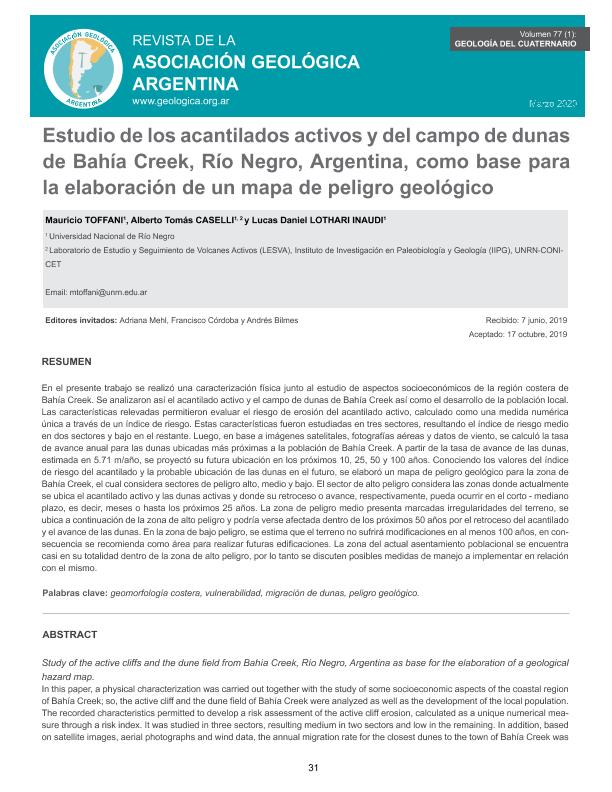Mostrar el registro sencillo del ítem
dc.contributor.author
Toffani, Mauricio

dc.contributor.author
Caselli, Alberto Tomás

dc.contributor.author
Lothari, Lucas Daniel

dc.date.available
2022-03-07T18:51:17Z
dc.date.issued
2020-03
dc.identifier.citation
Toffani, Mauricio; Caselli, Alberto Tomás; Lothari, Lucas Daniel; Estudio de los acantilados activos y del campo de dunas de Bahía Creek, Río Negro, Argentina, como base para la elaboración de un mapa de peligro geológico; Asociación Geológica Argentina; Revista de la Asociación Geológica Argentina; 77; 1; 3-2020; 31-46
dc.identifier.issn
0004-4822
dc.identifier.uri
http://hdl.handle.net/11336/152993
dc.description.abstract
En el presente trabajo se realizó una caracterización física junto al estudio de aspectos socioeconómicos de la región costera de Bahía Creek. Se analizaron así el acantilado activo y el campo de dunas de Bahía Creek así como el desarrollo de la población local. Las características relevadas permitieron evaluar el riesgo de erosión del acantilado activo, calculado como una medida numérica única a través de un índice de riesgo. Estas características fueron estudiadas en tres sectores, resultando el índice de riesgo medio en dos sectores y bajo en el restante. Luego, en base a imágenes satelitales, fotografías aéreas y datos de viento, se calculó la tasa de avance anual para las dunas ubicadas más próximas a la población de Bahía Creek. A partir de la tasa de avance de las dunas, estimada en 5.71 m/año, se proyectó su futura ubicación en los próximos 10, 25, 50 y 100 años. Conociendo los valores del índice de riesgo del acantilado y la probable ubicación de las dunas en el futuro, se elaboró un mapa de peligro geológico para la zona de Bahía Creek, el cual considera sectores de peligro alto, medio y bajo. El sector de alto peligro considera las zonas donde actualmente se ubica el acantilado activo y las dunas activas y donde su retroceso o avance, respectivamente, pueda ocurrir en el corto - mediano plazo, es decir, meses o hasta los próximos 25 años. La zona de peligro medio presenta marcadas irregularidades del terreno, se ubica a continuación de la zona de alto peligro y podría verse afectada dentro de los próximos 50 años por el retroceso del acantilado y el avance de las dunas. En la zona de bajo peligro, se estima que el terreno no sufrirá modificaciones en al menos 100 años, en consecuencia se recomienda como área para realizar futuras edificaciones. La zona del actual asentamiento poblacional se encuentra casi en su totalidad dentro de la zona de alto peligro, por lo tanto se discuten posibles medidas de manejo a implementar en relación con el mismo.
dc.description.abstract
In this paper, a physical characterization was carried out together with the study of some socioeconomic aspects of the coastal region of Bahía Creek; so, the active cliff and the dune field of Bahía Creek were analyzed as well as the development of the local population. The recorded characteristics permitted to develop a risk assessment of the active cliff erosion, calculated as a unique numerical measure through a risk index. It was studied in three sectors, resulting medium in two sectors and low in the remaining. In addition, based on satellite images, aerial photographs and wind data, the annual migration rate for the closest dunes to the town of Bahía Creek was calculated. According to the migration rate of the dunes, estimated at 5.71 m/year, its future location was projected in the next 10, 25, 50 and 100 years. Knowing the risk index values of the cliff and the probable location of the dunes in the future, it was possible to draw up a geological hazard map for the Bahía Creek area, which was subdivided into high, medium and low hazard. The high hazard zone considers the areas where the active cliff and active dunes are currently located and where their retreat or advance, respectively, may occur in short - medium term, i.e., months or until the next 25 years. The medium hazard zone presents marked irregular terrain and is located next to the high hazard zone and may be affected within the next 50 years by the retreat of the cliff and the dune migration. On the low hazard zone, it is inferred that it will not be modified in a lapse of at least 100 years, consequently it is advisable to build there in the future. The area of the current population settlement is almost entirely within the high hazard zone. Therefore, likely management measures to be implemented in relation to it are discussed.
dc.format
application/pdf
dc.language.iso
spa
dc.publisher
Asociación Geológica Argentina

dc.rights
info:eu-repo/semantics/openAccess
dc.rights.uri
https://creativecommons.org/licenses/by-nc/2.5/ar/
dc.subject
GEOMORFOLOGÍA COSTERA
dc.subject
VULNERABILIDAD
dc.subject
MIGRACIÓN DE DUNAS
dc.subject
PELIGRO GEOLÓGICO
dc.subject.classification
Otras Ciencias de la Tierra y relacionadas con el Medio Ambiente

dc.subject.classification
Ciencias de la Tierra y relacionadas con el Medio Ambiente

dc.subject.classification
CIENCIAS NATURALES Y EXACTAS

dc.title
Estudio de los acantilados activos y del campo de dunas de Bahía Creek, Río Negro, Argentina, como base para la elaboración de un mapa de peligro geológico
dc.title
Study of the active cliffs and the dune field from Bahía Creek, Río Negro, Argentina as base for the elaboration of a geological hazard map
dc.type
info:eu-repo/semantics/article
dc.type
info:ar-repo/semantics/artículo
dc.type
info:eu-repo/semantics/publishedVersion
dc.date.updated
2021-09-06T20:37:13Z
dc.identifier.eissn
1851-8249
dc.journal.volume
77
dc.journal.number
1
dc.journal.pagination
31-46
dc.journal.pais
Argentina

dc.journal.ciudad
Ciudad Autónoma de Buenos Aires
dc.description.fil
Fil: Toffani, Mauricio. Universidad Nacional de Río Negro; Argentina
dc.description.fil
Fil: Caselli, Alberto Tomás. Consejo Nacional de Investigaciones Científicas y Técnicas. Centro Científico Tecnológico Conicet - Patagonia Norte. Instituto de Investigación en Paleobiología y Geología; Argentina. Universidad Nacional de Río Negro; Argentina
dc.description.fil
Fil: Lothari, Lucas Daniel. Consejo Nacional de Investigaciones Científicas y Técnicas; Argentina. Universidad Nacional de Río Negro; Argentina
dc.journal.title
Revista de la Asociación Geológica Argentina
dc.relation.alternativeid
info:eu-repo/semantics/altIdentifier/url/https://revista.geologica.org.ar/raga/article/view/25
Archivos asociados
